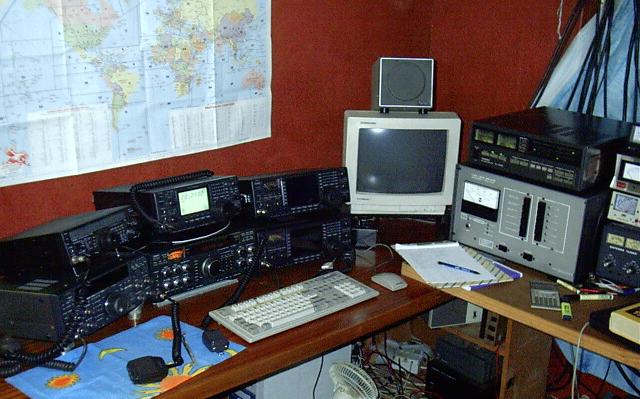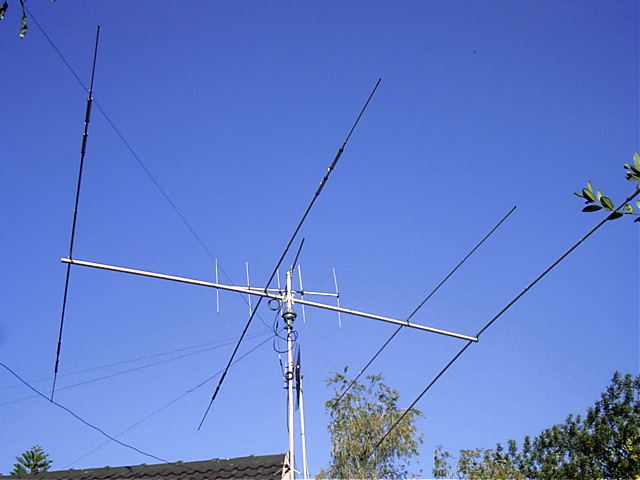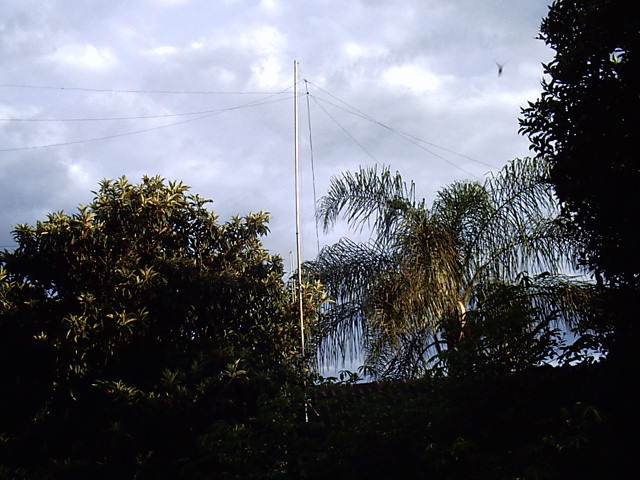 Contest
Station
Description
Contest
Station
Description 
 Contest
Station
Description
Contest
Station
Description 
 A never ending quest for better scores
A never ending quest for better scores 
![]()
I am only keeping this page here for historic reasons,
you can read more about my current station
HERE!
Update 1/7/2014:
Most of the information below is now outdated as it was last updated in 2003.
I am now busy rebuilding my contest station. I am keeping the information
below for no other than historic reasons. As the new station takes shape I
will update this page. You can read
HERE about my quest to find a
new contest radio(s). I still have most if not all of the equipment mentioned
below but as a lot of it is now rather dated I have decided to start a
Radio Museum and move the older
equipment to the museum. Other more recent equipment will be used for "rag
chewing" or field stations, if it fits into non of the above categories I will
dispose of it.
Historic station information dating from
before 2004
The current contest setup, setup for a SSB contest.
Here is a short description of the radio equipment, amplifiers, antennas, computers and software currently used at ZS6DX for competitions, both SSB, CW and hopefully digital in the near future.
For single band contests, SSB and CW, I currently use an IC-756, if it is a QRO contest I would normally use the T1000 solid state amplifier. This combination will then be connected to the antenna of choice, normally the Cushcraft A4S or the new TH7DX for 10,15 or 20m or the inverted V's for the lower bands. On 40m for DX contests I normally use a vertical loop antenna.
For multi band contests I currently use 2 x IC-756 radios on 10,15 and 20m, the one connected to the T1000 amplifier and the other one to the FL-7000 amplifier. The main radio will be connected to the TH7DX with the second radio connected to the Cushcraft A4S. The first radio will then be used on the band that is at any point in time is the "most" open and the run rates are the highest. The second radio will be used concurrently to continuously look for band openings and work multipliers. This is something that I am still practicing as 2 radios, both with dual watch can become a bit confusing! If I find the second band that I am listening to becomes more productive the main radio, the main radio will be moved to that band. Using 2 radios of exactly the same model helps to avoid confusion in the heat of the moment! For CW contests these radios are fitted with 250Hz filters in the 9MHz stage and 500Hz filters in the 455KHz stage. This along with the TPBF and the APF functions makes them great for busy band use and I have never felt "crowded" even in popular contests with good openings.
For multi band contests I also use a third radio, normally the TS-870S or the FT-990, connected to a HL-2200 amplifier using 2 x 3-500Z tubes, to listen for openings and make Q's on 40 and 80m. With the superb digital filters on the TS-870S or the SCAF filter on the FT-990 it is a pleasure to use them on the noisy lower bands.
I use computer logging in all contests (is there any other way?) and also for day to day DX'ing. For contest use I have been using SD till recently, it is fast and easy to use but the lack of multi tasking, it really MUST run on a DOS system if you want to use the keyer option, have made me change to Lux-log for the last few contests. SD does not (the version I have) support Cabrillo format so the upgrade also made sending in the logs easier. I have lost lots of contacts in the past when I used the "Shell to DOS" option in SD, be aware that it can throw away lots of contacts and you won't even know it till after the contest. I have tried many different logging programs but very few of the newer ones are user friendly enough to use in a contest where seconds count. During a contest you do not have time to move your hand from the keyboard to the mouse and back all the time so I prefer a logging program that does not need the mouse to operate. The older ones like SD, CT and TR work very well but they are not 100% compatible with Windows 2000 and above. I have been using LOGGER (version 8.07) for quite a while now for normal day to day logging and it really works well. It is also easy to import ADIF files from the contest logger to keep the main call database up to date. I have looked at the new 32 bit version of LOGGER but I must say I find it rather confusing and I won't be using it in the near future.
The PC that I am currently using is a home assembled clone with a 2.4GHz Pentium IV, 512MB ram and a 40GB hard drive as well as a 20GB hard drive used to backup important files. This computer is quiet on most bands with only a few spots of weak noise. I have a few chokes on all leads going into the computer, both to prevent the leads from radiating and also to keep RF out of the PC. I find with most PC's you need a choke on the keyboard cable if you are going to be running QRO. I use a Sound Blaster AWE64 sound card for the digital modes and as a voice keyer on SSB. This computer is an overkill as I used to use a 233MHz Pentium 1 and it worked fine till it caught fire ! I also have a MFJ 1273 TNC connected to this computer for packet but since we do not really have a packet cluster for spotting here in my area it is of no use during contests. A 56K dialup modem connects this computer to the internet. I am planning to upgrade this to an ISDN connection in the near future, as soon as the local Telkom company wakes up :-). I also keep a Compaq laptop and ready as a backup incase of computer failure or a power failure. I do have a UPS that can run the computer for many hours if needed. The second operating position is also equipped with a 1.7GHz Pentium IV so it can be used in an emergency.
If I have a power failure during a contest I currently have to revert back to 100W, I have a bank of 4 x 120Ah 12V batteries that can keep all my radios running for many hours. I also have a 75W solar panel and a 1.8Kw generator that can be used to recharge the batteries should we have a long power outage (this is Africa after all !). Since I have been entering most contests lately in the QRP category power is not a problem !
During CW contests I use the keyer feature of the logging program for all normal exchanges but I have a paddle connected to answer special requests or send a quick repeat.
For SSB contests I use the same logging software but I also use a voice keyer like AAVoice, it works well and saves the vocal cords! My TS-870 has a voice keyer build in so for 40 and 80m I normally just use that.
I do sometimes use headphones, when conditions are poor or if it is a multi operator contest entry it is a must but for single operator entries I find it less fatiguing to use a good outboard speaker.
For major contests I remove all other equipment from the bench to make it as uncluttered as possible.

The Cushcraft A4S that is used as the secondary 10,15 and 20m antenna. The A4S is a far better antenna than the TH5DX that it replaced for use with the second band radio. The primary antenna is now a TH7DX (photo coming soon...)

Spiders web of Dipoles for 40 and 80m that are used during contests.

Contesting the African way - by candle light after power failure! Note that I only keep the needed equipment on the bench for a contest!
I have now finished building 5 element mono-banders for 10, 15 and 20m. As soon as the new tower is up they will be installed. I also need to do something better for 160m, currently I am using a 60m long long-wire.